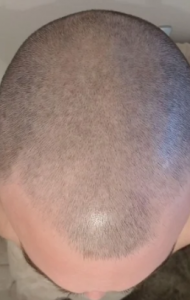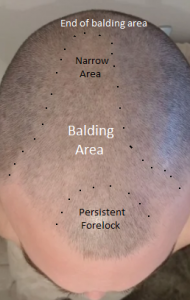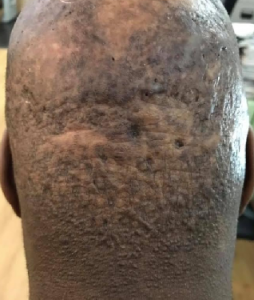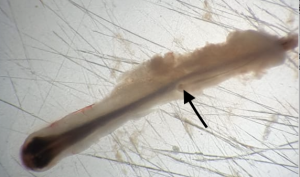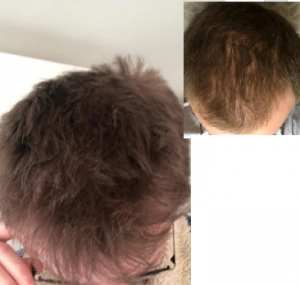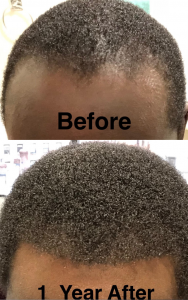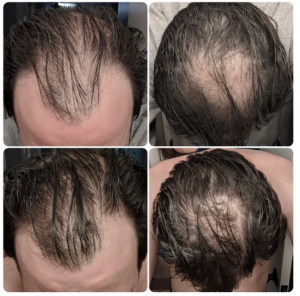This is an easy pattern for an expert’s eye to predict as outlined (in the right photo I marked up the left photo). The Norwood Class 5A pattern has a narrow crown component and when this man completes his balding pattern he will be bald back to the top of his crown (indicated on the photo). What is significant is the persistent forelock which has hair that is stronger than the surrounding hair. These forelocks tend to run in families and if this man keeps his forelock until he is 35, it is likely he could maintain it in the long term. Looking back at his family patterns, he should see if his father or grandfathers had this persistent juvenile hairline into older ages. From a transplant perpective, when this man’s balding becomes significant enough to require a hair transplant, having an “A” pattern is good news because almost everyone with the ‘A’ type patterns always have enough hair to get a full head of hair restored.
So I started taking finastaride on Saturday the 22nd of June. And here is what I have taken. Saturday 0.25mg Sunday missed a pill (hurt my leg playing football and was in hospital for scans) Monday 0.25 Tuesday 0.25 Wednesday 0.25
So here’s my question. I have taken in total 1mg of finastaride and last (Thursday)I have started to have an irrated nipple to the point where it feels like it has been chaffing on my T-shirt’s( I was wearing a rough embroider shirt) I’ve had no other sides (for now) and I am well aware that this could be in my head and I am a massive over thinker in these types of situations but the things that are swaying me to thinking gyno is:
I had gyno as a pubescent teenager (had the full lumps and everything during puberty, it wasn’t bad and it didn’t make it look puffy but it was there I think)
I had a doctors appointment today and i mentioned my symptoms and how I was feeling, I was had told my doctor I had been on finastaride for 2 weeks (obviously a lie, was a brain lag it’s not even been 1 week) and she felt around my pectoral area and she said my left hand side (which is the tender/irrated one) is slightly fuller than my right. But my right is also a bit fuller.
So my question is, do you guys believe this could be gyno? My doctor recommended to stop for 2 weeks and see what happens to the symptoms. I’m just unsure how fast gyno can happen?? I really don’t want to lose my hair so I’m debating whether taking a SERM with finastaride??
Thanks a lot for listening and I’ll be very grateful to listen to anything
After a single dose or a limited dose, I doubt that the gynecomastia would get worse. Considering your history, I would think that you are too much focused on this side effect and .what you are experiencing may be a nocebo effect. Seeing your doctor is a good idea.
I’m considering to get a procedure done and was wondering if there are difference between FUE procedures or are they all about the same? What are some important questions to ask when deciding on a doctor besides ‘how long have you been doing this’?
FUEs vary between doctors because each doctor uses a different type of hand ‘punch’ and smaller ones (up to a limit), leave smaller, less detectable scars. The problem with FUE is that the number of grafts removed safely is absolutely related to the density of the hair in the back of the head. The higher the donor hair density, the more FUE grafts can be taken, while in a person with a low donor density (a typical Asian, Indian or middle easterner) might have a normal lower hair density than a typical Caucasian from Northern Europe. This rule also applied to the Hair Mass Index of the hair, the higher the index, the more FUE grafts can be safely removed. If a doctor takes too many hair grafts out, then you can get balding in the back and sides of your head from the FUE (see here: https://baldingblog.com/collection-victim-photos-internet-harvested-depleted-donor-areas/ ) which is something that the doctors don’t have to live with, you do. Worst, 90% of the people doing the FUEs in Turkey are not doctor so that certainly with an non-professional person doing your surgery may be VERY common in people receiving surgery in Turkey.
I was the person who pioneered the FUE in 2002 when I published the first paper and presented it at the first meeting all in the same month. I gave out 600 DVDs showing what an FUE looked like. Then, within a week, doctors from all over the world started doing it and doing it very poorly. My video was only 2 minutes long and it was not made to teach the doctors all of the nuances of the FUE. Even today, many doctors don’t understand it well. I, with my partner Dr. Pak, also invented the robot that does the FUE holding two patents for the technology. We licensed it to the company that made the ARTAS robot. Here is our original article that opened up the FUE business: https://newhair.com/wp-content/uploads/2018/11/mp-2002-fue.pdf
You must find a doctor who is skilled in the process and you can tell by asking to meet some of his patients and then look carefully at the donor area for the type of scarring that is evident (my link above shows it). Ask your doctor for his measurement of your original donor density and his assessment of how many grafts he believes you can support in your lifetime. Too many doctors take out too many grafts with FUE causing the problems I demonstrated above.
This is a very comprehensive video that might save your life and your parent’s lives
Washing your hair daily is never a problem–just be gentle with it. When you are too vigorous, you pull out the miniaturized hairs very easily.
I am a 21 year old female suffering from traction alopecia. Unfortunately, due to my work I have to wear my hair in tight ponytails. I believe this has caused me to lose hair around my temples. What are my options ?
I would like to know if it is present on the other side as well. Sometimes a condition called Triangular Alopecia can cause a pattern of hair loss like this, but not as large. As your history is consistent with traction as a cause, then a hair transplant is the perfect answer, regardless of the cause.
Is it true that a trained doctor or professional can predict an someone final hair loss pattern?
Not 100%, however using family history, timing your appearance of balding (when you started), how fast it is moving, miniaturization analysis and most important if you have a significant amount of hair get a HAIRCHECK test (https://baldingblog.com/haircheck-test-how-it-is-done-video/), then I might be reasonably confident I could advise you on your final balding pattern, especially if you are over 25 years of age.
I tell men that if they get a hair system when they are young, the hair system attachments (glues, clips, etc..) cause loss of the hair on your scalp and you become more bald and more dependent upon the hair system. Hair transplants can solve the problem but the balder you get, the higher the costs so keep that in mind.
Page 223 of 634

